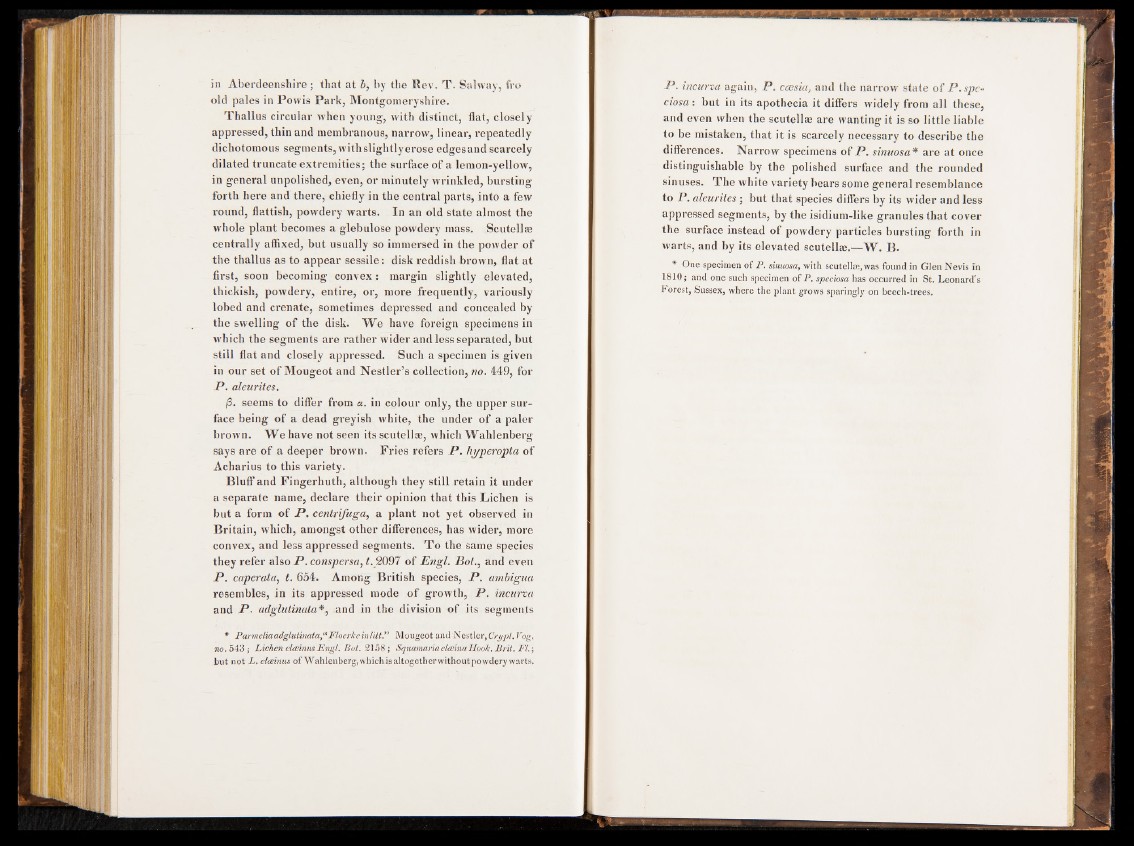
in Aberdeenshire; that at b, by the Rev. T. Salvvay, fro
old pales in Powis Park, Montgomeryshire.
Thallus circular when young, with distinct, flat, closely
appressed, thin and membranous, narrow, linear, repeatedly
dichotomous segments, withslightlyerose edges and scarcely
dilated truncate extremities; the surface of a lemon-yellow,
in general unpolished, even, or minutely wrinkled, bursting
forth here and there, chiefly in the central parts, into a few
round, flattish, powdery warts. In an old state almost the
whole plant becomes a glebulose powdery mass. Scutellae
centrally affixed, but usually so immersed in the powder of
the thallus as to appear sessile: disk reddish brown, flat at
first, soon becoming convex: margin slightly elevated,
thickish, powdery, entire, or, more frequently, variously
lobed and crenate, sometimes depressed and concealed by
the swelling of the disk. We have foreign specimens in
which the segments are rather wider and less separated, but
still flat and closely appressed. Such a specimen is given
in our set of Mougeot and Nestler’s collection, no. 449, for
P . aleurites.
(3. seems to differ from «. in colour only, the upper surface
being of a dead greyish white, the under of a paler
brown. We have not seen its scutellae, which Wahlenberg
says are of a deeper brown. Fries refers P . hyperopta of
Acharius to this variety.
Bluff and Fingerhuth, although they still retain it under
a separate name, declare their opinion that this Lichen is
but a form of P . centrifaga, a plant not yet observed in
Britain, which, amongst other differences, has wider, more
convex, and less appressed segments. To the same species
they refer also P . conspersa, t. 2097 of Engl. Bot., and even
P . caperata, t. 654. Among British species, P. ambigua
resembles, in its appressed mode of growth, P. incurva
and P . adglutinata*, and in the division of its segments
* Parmelia adglutinata,“Floerke inlilt.” Mougeot and Nestler,CVy/j/. Vog.
no. 543; Lichen elaeinusEngl. But. 2158; Squamariaelceina TIook. Brit. FI.;
but not L. elaeinus of Wahlenberg, whichisaltogetherwithoutpowdery warts.
P . incurva again, P. cæsia, and the narrow state of P . spe-
ciosa : but in its apothecia it differs widely from all these,
and even when the scutellae are wanting it is so little liable
to be mistaken, that it is scarcely necessary to describe the
differences. Narrow specimens of P. sinuosa* are at once
distinguishable by the polished surface and the rounded
sinuses. The white variety bears some general resemblance
to P. aleurites ; but that species differs by its wider and less
appressed segments, by the isidium-like granules that cover
the surface instead of powdery particles bursting forth in
warts, and by its elevated scutellae.—W. B.
* One specimen of P. sinuosa, with scutellæ, was found in Glen Nevis in
1810; and one such specimen of P. speciosa has occurred in St. Leonard's
Forest, Sussex, where the plant grows sparingly on beech-trees.